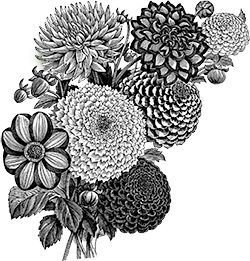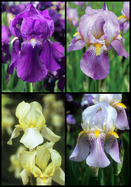Though preservation is our mission, bulbs drop out of our catalog every year.
Sometimes it’s because the harvest was too small. Sometimes it’s because they’re widely available elsewhere and don’t need our help. And sometimes it’s because we’ve lost our only known source due to severe weather (cold, drought, etc.), health problems (a debilitating stroke), or economic woes (small farmers are always at risk).
The good news is that, in time, we’re often able to return these bulbs to our catalog. So here’s a list of many we’ve offered in the past. For an alert the moment they’re available again, subscribe to our free email newsletter. Or to find a similar bulb, try our easy Advanced Bulb Search.
|
|
|
|
|
|
|
Icons of the late-spring/early-summer garden, bearded iris are easy to grow and richly diverse. Give them full sun and average to well-drained soil and they’ll reward you for close to forever. We’ll send you 3 of our favorite heirlooms (a few possibilities are pictured here), all different, labeled, freshly dug from our Ann Arbor micro-farm, and great for zones 3a-8a(10aWC).
For more of each variety, order additional samplers.
If you’d like to be notified the next time we offer this treasure, click to sign up for an email alert.
Spring shipped, click here for summer shipped.
|
|
|
|
We’re big fans of smaller iris. They’re graceful, charming, and – at about two feet tall – combine beautifully with other perennials near the front of a sunny border. We’ll send you 3 of our favorites (a few possibilities are pictured here), all different, labeled, freshly dug from our Ann Arbor micro-farm, and great for zones 3a-8a(10aWC).
For more of each variety, order additional samplers.
If you’d like to be notified the next time we offer this treasure, click to sign up for an email alert.
Spring shipped, click here for summer shipped.
|
|
|
|
This famous iris is not only magnificently handsome, it’s also “a survivor par excellence,” to quote expert Cameron Hall, growing vigorously in old gardens and forgotten places from coast to coast. Introduced by Vilmorin of France, it was one of the first tetraploids, setting a ground-breaking new standard – taller, larger-flowered, and richly colored – for 20th-century iris. 38-40”, zones 3a-8a(10aWC), from our Ann Arbor micro-farm.
Last offered in 2023. If you’d like to be notified the next time we offer this treasure, click to sign up for an email alert.
|
|
|
|
With velvety falls of deep oxblood to burgundy, this small-flowered French iris was the “reddest” of its era, and it’s still a knockout today. Strong-growing and floriferous with a light fragrance that’s been compared to honey locust, it’s an iris that, as Lee Bonnewitz wrote in his 1926 catalog, “I believe all American iris lovers will be glad to own.” 30-32”, zones 3a-8a(10bWC), from our own micro-farm.
Last offered in 2024. If you’d like to be notified the next time we offer this treasure, click to sign up for an email alert.
|
|
|
|
The perfect yellow iris? Could be! It’s not too pale, not too bright, tough enough to thrive in total neglect, and it blooms and blooms – often after all the other iris here in our micro-farm have called it quits for the season. Introduced by Agnes Moore of tiny Benton, Illinois, it has become, in the words of iris expert Mike Unser, “truly an iris classic.” 28-36”, zones 3a-8a(10bWC), from our own micro-farm.
Last offered in 2024. If you’d like to be notified the next time we offer this treasure, click to sign up for an email alert.
|
|
|
|
The deep, almost iridescent red-purple of this fragrant iris – which cameras fail to capture – dazzled the world when it was first introduced by the legendary Peter Barr. Its blooms are often the first of iris season, and in zone-6 and warmer gardens it often reblooms in the fall. In fact, it’s become “ubiquitous in coastal California,” writes Clarence Mahan in Classic Irises, “where its reblooming habit has given it a place in the hearts and flower beds of generations of gardeners.” Just 22-26” tall, zones 3a-8a(10bWC), from our own micro-farm.
Last offered in 2024. If you’d like to be notified the next time we offer this treasure, click to sign up for an email alert.
|
|
|
|
With velvety petals of burgundy and rose, ‘Dauntless’ is one of the oldest and best of the so-called “red” irises. It was introduced by Nashville’s Clarence Connell in 1929, beating out ‘Indian Chief’ to win the Dykes Medal as the year’s finest iris. On “tall heavy stems,” its luxurious blooms “last over a long season” (Cooley’s, 1937). 34-38”, zones 3a-8a(10bWC), from our own micro-farm.
Last offered in 2024. If you’d like to be notified the next time we offer this treasure, click to sign up for an email alert.
|
|
|
|
After years of building up stock, we’re finally able to offer this unique little iris. Demi-deuil means “semi-mourning,” the period after full mourning when Victorians dressed in black and white, but by 1912 it was more commonly the name of a small, black and white butterfly. With its intricate filigree of darkest purple on white with touches of gold and brown, ‘Demi-Deuil’ is especially stunning up close, so be sure to pick at least one to enjoy indoors. 20-24”, zones 3a-8a(10bWC), from our own micro-farm.
Last offered in 2024. If you’d like to be notified the next time we offer this treasure, click to sign up for an email alert.
|
|
|
|
With its lower petals held out at a jaunty angle, this profusely blooming little iris really does have the look of a host of butterflies. It was bred by the remarkable Grace Sturtevant of Massachusetts, a trained artist and “the world’s first woman plant hybridizer” (Mahan, 2007). 24-26”, zones 3a-8a(10aWC), from our Ann Arbor micro-farm.
Last offered in 2025. If you’d like to be notified the next time we offer this treasure, click to sign up for an email alert.
|
|
|
|
By Ferdinand Cayeux, perhaps the greatest iris breeder of all time, this big, stately iris features pale, rippled standards of lilac and fawn over falls of deep, velvety maroon shading to violet. Our stock of this rarity is very limited, and it will be years before we can offer it again, so get it while you can! 38-46”, zones 3a-8a(10bWC), from our Ann Arbor micro-farm.
Last offered in 2015. If you’d like to be notified the next time we offer this treasure, click to sign up for an email alert.
|
|
|
|
With its exotic blend of parchment, bronze, rust, rose, and oxblood, this intriguing iris adds a note of “unusual warmth and vibrancy” (Schreiner’s, 1946) to the early summer garden. It was bred in Elkhart, Indiana, by E.G. Lapham, president of the Elkhart Rubber Works, who swore that the irises he grew behind his factory weren’t a distraction but a “life-saver.” 38-46”, zones 3a-8a(10bWC), from our own micro-farm.
Last offered in 2024. If you’d like to be notified the next time we offer this treasure, click to sign up for an email alert.
|
|
|
|
At Wave Hill, the legendary Marco Polo Stufano championed hundreds of little-known but fabulous flowers, including this classic iris. Just two feet tall, it melds happily into perennial gardens where its luminous, pale gold standards over a lacework of raisin-purple give it a regal presence. Tough and floriferous, 20-24", zones 3a-8a(10bWC), from Ann Arbor.
Last offered in 2021. If you’d like to be notified the next time we offer this treasure, click to sign up for an email alert.
|
|
|
|
There’s a lot more to this iris than a great name. It’s Canadian-bred, so you know it’s tough, its stems are tall and sturdy, and its profuse, handsome flowers seem to reflect the summer sky. Winner of the Dykes Medal, it was “unquestionably the finest of all blue iris” for decades (Wayside, 1954). With a fragrance that’s been compared to magnolias, 36-40”, zones 3a-8a(10bWC), from Ann Arbor.
Last offered in 2016. If you’d like to be notified the next time we offer this treasure, click to sign up for an email alert.
|
|
|
|
Last offered spring 2021. Subtle and small-flowered, this rarely offered beauty will never be mistaken for a modern iris. It’s an intriguing blend of soft lavender shaded at the edges by even softer brown – yes, brown! – and brightened by a glow in the center that spills out on its golden beards. Due to limited space in our micro-farm, we’re offering it one time only, so get it while you can! Aka ‘Dove’, ‘Agnes Sorrel’, ‘Pluton’, ‘Rosamond’, and ‘Candicans’. 22-26”, zones 3a-8a(10bWC), from Ann Arbor.
If you’d like to be notified the next time we offer this treasure, click to sign up for an email alert.
|
|
|
|
The perfect size for bouquets, and luminous in the garden, this elegant small iris is named for Maud du Puy, the Philadelphia-born wife of one of Darwin’s sons. Although often confused with its sister ‘Mrs. Horace Darwin’ (which we offered last year), it’s laced with gold and purple (not just purple) and blooms later (extending the sisterly season). 24”, zones 3a-8a(10bWC), from Ann Arbor.
Last offered in 2023. If you’d like to be notified the next time we offer this treasure, click to sign up for an email alert.
|
|
|
|
Although named in 1813, this wild hybrid of I. pallida and I. variegata was probably grown in gardens long before that. Today several similar clones are grouped under this name, all short and small-flowered with pale lavender standards over jaunty little falls that are richly veined with purple – and as the Biltmore Nursery catalog noted in 1912, “most desirable.” Due to limited space in our micro-farm, we’re offering this wild jewel one time only, so get it while you can! 20-14”, zones 3a-8a(10bWC), from Ann Arbor.
Last offered in 2016. We offer a rotating selection of iris. If you’d like to be notified the next time we offer this treasure, click to sign up for an email alert.
|
|
|
|
The deep, warm, radiant yellow of this Dykes Medal winner continues to astonish gardeners nearly 70 years after it was first introduced by Jacob Sass of Nebraska. Its beards are orange, its tall stalks never topple, and it multiplies vigorously. In short, as its Greek name declares, it’s “all good.” 36-38”, zones 3a-8a(10bWC), from Ann Arbor.
Last offered in 2013. If you’d like to be notified the next time we offer this treasure, click to sign up for an email alert.
|
|
|
|
If you’d like to be notified the next time we offer this treasure, click to sign up for an email alert.
|
|
|
|
“Well named,” wrote Nebraska nurseryman Charles Harrison in 1916, “tall and queenly, with a profusion of bloom of radiant and glistening purple.” Nearly a century later, iris expert Mike Unser agrees, saying ‘Perfection’ is “true to its name . . . with exceptional color, flawless form, vigorous growth” and even “beautiful foliage.” Flaring falls and splashes of darker purple on its standards add to its appeal. 28-34”, zones 3a-8a(10bWC), from Ann Arbor.
Last offered in 2016. We offer a rotating selection of iris. If you’d like to be notified the next time we offer this treasure, click to sign up for an email alert.
|
|
|
|
This fragrant little iris is a fascinating mix of jewel-like colors that photos can only hint at. “Coppery rose” over “velvety claret” is how the legendary Bertrand Farr described it in 1920, while other have called it “rosy mauve with metallic sheen” over “red-violet, edged gold-brown.” Early and free flowering, it’s an iris we look forward to every year. (Please note: Recent research by Anner Whitehead has convinced us that ‘Plumeri’ dates to 1888, not 1830.) 28-32”, zones 3a-8a(10bWC), from Ann Arbor.
Last offered in 2025. If you’d like to be notified the next time we offer this treasure, click to sign up for an email alert.
|
|
|
|
This radiant little iris won my heart long before I learned its name. A new neighbor rescued a single rhizome from the shade of overgrown shrubs, and before long it had multiplied into a big clump of one of the most beautiful iris I’d ever seen. Blooming abundantly, it has luminous, pale yellow standards over bright, rosy purple falls for an effect that’s absolutely scintillating. 20-24”, zones 3a-8a(10bWC), from our Ann Arbor micro-farm.
Last offered in 2017. If you’d like to be notified the next time we offer this treasure, click to sign up for an email alert.
|
|
|
|
One of the best-loved American iris of all time, ‘Quaker Lady’ is a “dainty, charming” plant with flowers of “smoky lavender, bronze, purple, fawn, and old gold” (to quote AIS founder John Wister). And though beauty is only skin-deep, ‘Quaker Lady’ is also sturdy and care-free, multiplies quickly, and blooms with abandon. All in all, it’s a worthy monument to its creator, Bertrand Farr, the visionary Pennsylvania nurseryman who did more than anyone else to make iris one of the signature plants of the early 20th-century garden. 27-30”, zones 3a-8a(10bWC), from our own micro-farm.
Last offered in 2024. If you’d like to be notified the next time we offer this treasure, click to sign up for an email alert.
|
|
|
|
Praised as “a delightful fantasy of colors” by the 1946 Schreiner’s catalog, this Dykes Medal winner is an ever-changing mix of iridescent bronze and old rose shading into deep russet and maroon. It’s remarkably tough and vigorous, too. As expert Winifred Ross wrote, “Once you have ‘Rosy Wings’, you always have it.” Lightly fragrant, 36-40”, zones 3a-8a(10bWC), from Ann Arbor.
Last offered in 2014. If you’d like to be notified the next time we offer this treasure, click to sign up for an email alert.
|
|
|
|
Grown by author Vita Sackville-West at Sissinghurst – one of the 20th century’s most iconic gardens – this pastel beauty was bred by T. Lloyd Pillow, superintendent of Pittsburgh’s Street and Sewer Department. On tall, strong stems, its primrose-and-cream standards over old-rose, almost-pink falls make it an iris that our garden visitors always notice and admire. 38-42”, zones 3a-8a(10bWC), from our Ann Arbor micro-farm.
Last offered in 2016. We offer a rotating selection of iris. If you’d like to be notified the next time we offer this treasure, click to sign up for an email alert.
|
|
|
|
The finest “pink” iris of the early 20th century, this lilac-rose beauty first sold for an unheard-of $75 each. For decades it was widely-praised for its “perfect form” (Wayman), “robust constitution” (Puget Sound), “freedom of flowering” (Hellings), and “appealing creamy pink tone” (Mead) which “blends well with almost any color” (Peckham) – and that’s all still true today. 30-34”, zones 3a-8a(10aWC), from our Ann Arbor micro-farm.
Last offered in 2016. If you’d like to be notified the next time we offer this treasure, click to sign up for an email alert.
|
|
|
|
Simple but stunning, ‘Wabash’ won the iris world’s top prize, the Dykes Medal, in 1940, and it’s still enormously popular today, often topping the annual polls of the Historic Iris Preservation Society. Its pure white standards glow above vibrant purple falls that are intensified by gold beards and a radiant edging of silver. 36”, zones 3a-8a(10bWC), from Ann Arbor.
Last offered in 2023. If you’d like to be notified the next time we offer this treasure, click to sign up for an email alert.
|
|






































